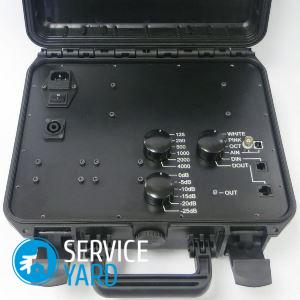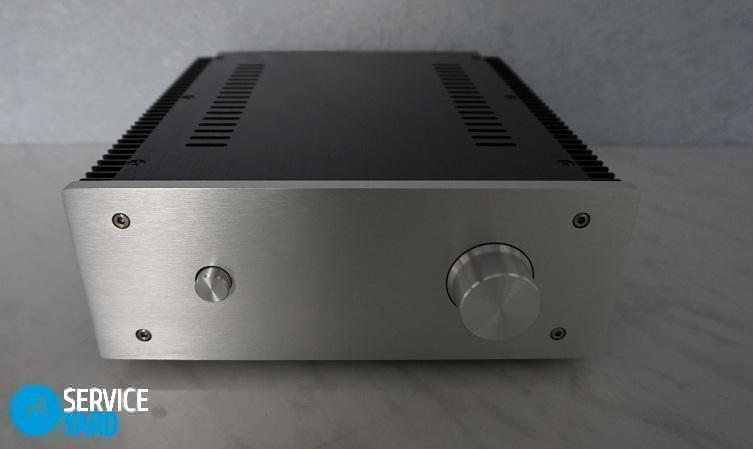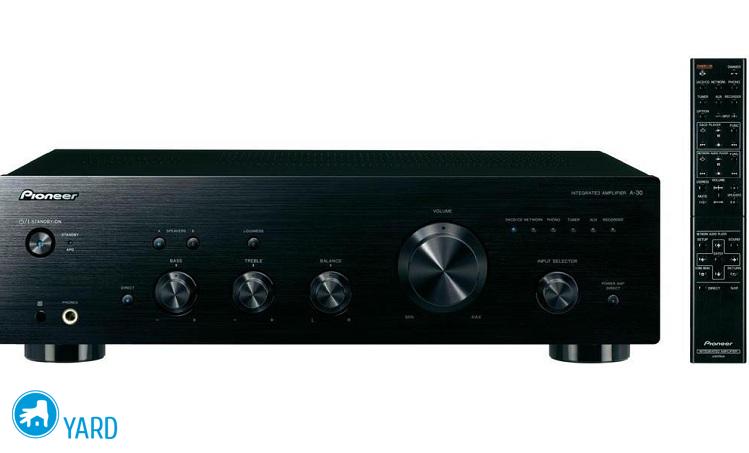Which sound amplifier is better?

Dancing on the site in front of the cottage, a karaoke party with friends, listening to your favorite CDs, a children's party with games to music - a player and computer speakers will obviously not be enough. But what if you have a big good car and you’re used to the music lifting your mood? The built-in subwoofer seems too primitive and does not provide the desired quality. Everything is clear - you need to buy a separate device to enhance power. Which sound amplifier is better? This will be discussed in our article.
to contents ↑What are the amplifiers?
When you open the audio equipment catalog, you will be surprised to find that the amplifier is different. They differ in many ways:
- type;
- elemental base;
- number of channels;
- power;
- distortion factor;
- minimum allowable load;
Type of
The type is determined by the functions that the device should perform. There are only three types:
- preliminary;
- terminal;
- complete.
Preliminary
The preamplifier, as the name implies, is designed to prepare a weak sound signal for amplification. Put it next to the sound source. This arrangement is convenient because it avoids interference.
The preamplifier consists of several blocks:
- switching inputs;
- volume and tone controls;
- the amplifier itself, which allows you to increase the signal power.
Important! A preamplifier is used with a power amplifier.
Terminal
This is a power amplifier. But this device is not only enhanced by power. With it, the signal is brought to a level. But it is impossible to adjust the signal parameters using such a device.
Full
It combines the functions of a preamplifier and a terminal. It is very convenient. As for the price, such a device will cost less than a set of preamplifier and finished amplifier.
to contents ↑What is inside it?
According to what elements are used, amplifiers are also divided into three types:
- tube;
- transistor;
- hybrid.
On the lamps
If you think which amplifier is better, try to determine for what purpose you need it. Lamp technology has a lot of advantages:
- relatively simple scheme;
- high sound quality;
- good timbre;
- low noise level;
- soft signal limitation;
- resistance to overloads;
- ease of setup;
- resistance to power failures.
True music lovers often choose precisely tube amplifiers. However, such devices have some disadvantages:
- high power consumption;
- heavy weight because heavy transformers are inside;
- an increase in power above 20 watts requires a change in circuit using scarce lamps.
Important! With an increase in power, weight and price inevitably increase.
Transistor devices
The operation of such amplifiers becomes possible due to the use of bipolar and field effect transistors. Circuits of such devices are more complicated than tube ones. The undoubted advantages include a relatively low cost and low weight. If we talk about the shortcomings, then they are:
- the need for additional protection of the output stages;
- the need to protect the power supply.
Important! Now, instead of discrete elements, such amplifiers often use integrated circuits, which are more compact and easy to repair.
Hybrids
Hybrid devices use both lamps and integrated circuits or transistors. Such amplifiers combine not only elements, but also the advantages and disadvantages of tube and transistor ones. There are a lot of options, so you can choose a sound amplifier that perfectly suits your goals.
If you try to determine the merits, you get a solid list:
- high sound quality and soft timbre, like a tube;
- relatively light weight;
- extensive price line;
- greater than transistor resistance to power failures.
How many channels are needed?
The number of channels depends entirely on which speaker system you use. Usually there are from one to six, although the hardware manufacturers are not limited to this anymore - you can also find devices with a much larger number of channels. The whole question is whether you need it.
The single-channel device gives monophonic sound, two channels provide stereo sound.
Important! Maximum quality is obtained if you follow the principle that the number of speakers and channels should be equal. Moreover, each column has its own personal channel, and each channel has its own column.
The amplifier for playing music must be at least two-channel in order to play stereo sound. For a home theater, the minimum configuration is 5.1. But there may be more interesting options - 9.2 configurations are also on sale. The number of channels is indicated in the documentation for the device.
to contents ↑Choose power
An amateur who decides to buy high-quality sound equipment is often lost - what to buy first, and then what? Professionals advise first to choose an acoustic system, and then choose an amplifier for it, depending on its configuration. This order is more convenient, since:
- Choosing an amplifier for an existing system is much easier than a system for an amplifier.
- System characteristics can tell you how much power the amplifier should have.
To choose a sound amplifier by power, you need to take into account some very simple considerations:
- Do not expect that the best quality sound will turn out at the limit of the power of the amplifier and speaker system. This almost never happens - the best sound is achieved at about 70-75% of the maximum power of the amplifier and about 90% of the system. That is, the amplifier should be about one and a half times more powerful than the rest of the equipment.
- You should not focus on the maximum value that is indicated in the certificates - you need to take into account the nominal value, since it ensures the specified level of distortion and long-term sound reproduction.
- Also keep in mind the sensitivity of the speaker system, which is measured in decibels: when the sensitivity decreases by 3 dB, but you want to get sound at the same volume, the amplifier power must be doubled.
Distortion coefficient
In fact, it consists of two coefficients:
- intermodulation distortion;
- harmonic distortion.
They are expressed as a percentage. Modern high-quality equipment is most often made according to the DIN 45500 standard. According to this standard, the following distortion parameters are set:
- intermodulation - not more than 3%, frequency band - 250-8000 Hz;
- harmonic - not more than 1%, frequency band - 40-12500 Hz.
Minimum load
The load resistance of the speaker system determines how much power the amplifier needs. The smaller it is, the more power is needed. However, it is also important what minimum load the column can withstand and does not burn out.
to contents ↑Signal and noise
The sounds that come out of the amplifying device are not the same.The signal is useful and noise. Useful - music or speech, for example. Noise - crackling and whistling, which sometimes produces equipment.
to contents ↑Important! This parameter is expressed in decibels. Suitable value for household appliances is 90-100 dB.
Some tips
It is generally accepted that the more expensive the equipment, the better. This is not necessarily the case. The price does not always determine the quality, but nevertheless, it must be borne in mind that a good device can not be too cheap. Unless you buy it at a thrift store where the most incredible accidents are possible.
You should not buy equipment where it cannot be checked. It makes sense to do this only in one case, if you have pre-selected the model and trust the seller.
to contents ↑Important! Consider also exactly what area you will be voicing - the approximate power of each channel is calculated per 1 square meter. The best option is 3-5 watts per 1 square. m
Subtleties of connection
Thinking how to choose an amplifier, be sure to pay attention to the features of connecting to speakers. In modern equipment, it can be of two types:
- on spring clips;
- on the terminals.
The second option is more convenient in all respects:
- terminals securely hold cables;
- the presence of such mounts indicates the high quality of the equipment.
Additional features
Almost all modern models have a built-in crossover. It is needed to cut low or high frequencies. In fact, this is a system of filters tuned to specific frequency components of the signal. It divides the signal into different frequency bands, directing them to acoustic emitters adapted for a given range.
In addition, modern amplification equipment has a smooth adjustment of the cutoff frequency. Many models are equipped with switches that allow you to multiply the frequency by 10, 100, etc. This makes it possible to amplify the signal in each channel without using an external crossover.
to contents ↑Important! If you have a high-quality speaker system and don’t need special effects like ultra-low bass, you won’t need a crossover.
How to choose the right amplifier for the car?
In many cases, drivers have enough built-in amplifier. However, owners of high-end cars often seek to increase the power of sound and put an additional column.
In this case, the weight of the equipment does not play a big role. Therefore, you can absolutely safely buy a tube amplifier that gives maximum sound quality.
As for the remaining parameters, they can be as follows:
- it should be a hybrid - it takes up much less space than the preamp and terminal amplifier combined;
- power is calculated based on the value of 3 kW per 1 sq. m (5 kW - better for rooms, and large);
- as in any other case, the amplifier should be suitable for a particular speaker system;
- connection with acoustics - using terminals;
- distortion factor - for high-end equipment.
Important! When buying, do not forget to look at the certificate, which must indicate the real power for a particular device with a specific serial number.
Where to put it?
This is an important issue, because the size of the device you choose depends on it. The amplifier can be supplied:
- on the back of the rear seat;
- under the seat;
- on the rear shelf;
- in the underground.
Amplifier for home
At home, you can put a hybrid device, and two separate ones - it all depends on the size of the room. The power is also considered from the area:
- if the area is less than 15 square meters m, power is calculated from 3 kW;
- if more than 20 sq.m - it is necessary to take the number 5.
Important! At the same time, it is worth taking care that the signal level at maximum values does not exceed the pain threshold, otherwise the music will be harmful.
Other features:
- The important point is distortion. They should be minimal.
- But the maximum frequency range is needed, then the sound quality will be high.
- As for the number of channels, the options may be different. Of course, now there are not so many lovers of monophonic sound, so a single-channel device is unlikely to suit you.
- Ideal for home - a universal device that can provide good sound when listening to audio recordings and when dubbing movies.
Stock footage
Now we have figured out all the intricacies of this seemingly difficult task. We hope that you can easily figure out which sound amplifier is better and not disappointed in the resulting quality.
- How to choose a vacuum cleaner taking into account the characteristics of the house and coatings?
- What to look for when choosing a water delivery
- How to quickly create comfort at home - tips for housewives
- How to choose the perfect TV - useful tips
- What to look for when choosing blinds
- What should be running shoes?
- What useful things can you buy in a hardware store
- Iphone 11 pro max review
- Than iPhone is better than Android smartphones






